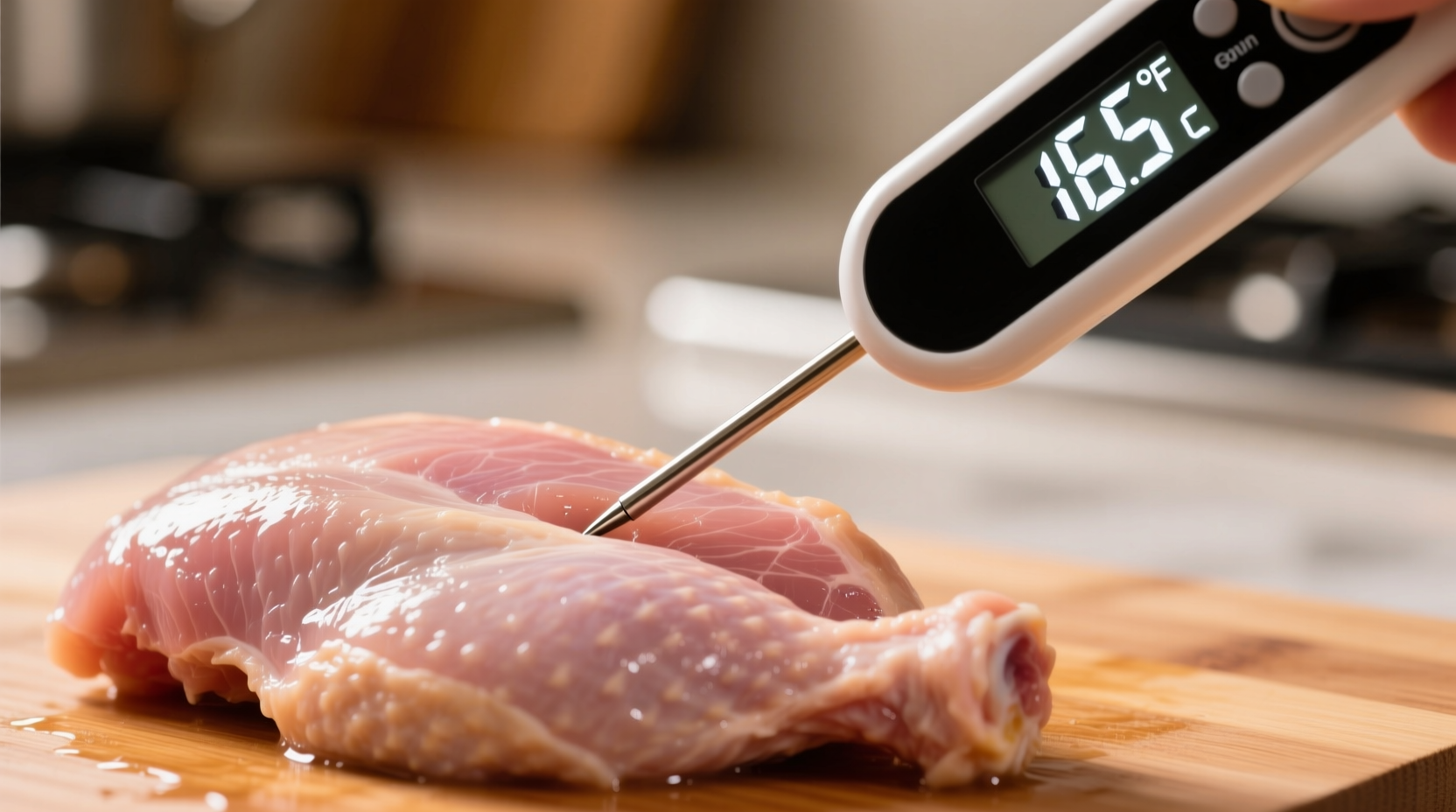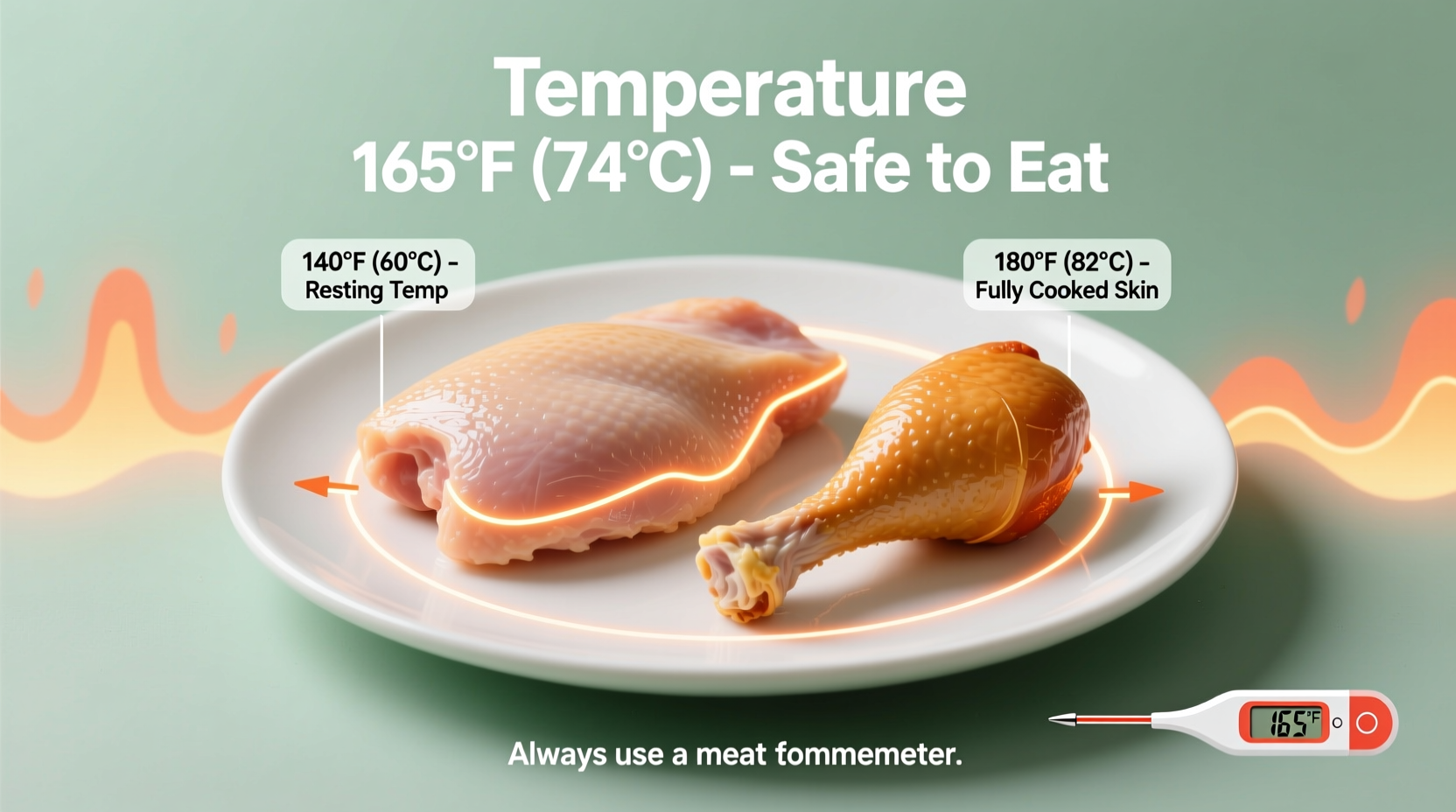Knowing the exact temperature to cook chicken isn't just about doneness—it's a critical food safety requirement that protects you and your family from potentially serious illness. As a home cook, understanding the science behind safe cooking temperatures empowers you to prepare chicken confidently while avoiding common mistakes that could compromise safety or quality.
The Science Behind Safe Chicken Cooking Temperatures
When you're preparing chicken, the 165°F (74°C) threshold isn't arbitrary. This specific temperature represents the point where dangerous pathogens like Salmonella and Campylobacter are instantly destroyed. According to the USDA Food Safety and Inspection Service, these bacteria can be present in raw poultry and must be eliminated through proper cooking.
What many home cooks don't realize is that temperature and time work together in food safety. While 165°F provides immediate pathogen destruction, lower temperatures can be safe if maintained for specific durations:
| Temperature | Required Holding Time | Practical Application |
|---|---|---|
| 145°F (63°C) | 8.5 minutes | Only suitable for sous vide cooking with precise temperature control |
| 150°F (66°C) | 2.8 minutes | Specialized cooking methods requiring exact timing |
| 155°F (68°C) | 47.7 seconds | Rarely practical for home cooking |
| 160°F (71°C) | 14.8 seconds | Still risky for unevenly cooked pieces |
| 165°F (74°C) | Instant | Recommended safe temperature for all home cooking methods |
This time-temperature relationship explains why the USDA recommends 165°F as the standard for home cooks—it provides an immediate safety margin without requiring precise timing that's difficult to achieve in typical kitchen environments. The data comes from thermal death time research conducted by the FDA and USDA, which you can verify in the USDA Food Safety and Inspection Service guidelines.
How to Accurately Measure Chicken Temperature
Knowing what temperature to cook chicken is only half the battle—you must measure it correctly. Many foodborne illness cases occur not because people don't know the safe temperature, but because they measure incorrectly.
Follow these professional thermometer techniques:
- Use an instant-read digital thermometer for best accuracy (tested to ±0.5°F)
- Insert the probe into the thickest part of the meat, avoiding bones
- Check multiple spots in larger pieces like whole chickens or roasts
- Wait 10-15 seconds for the reading to stabilize
- Sanitize your thermometer between readings
Don't rely on color changes or juice clarity as indicators—these visual cues are unreliable. Chicken can appear done (white with clear juices) at temperatures as low as 150°F, still leaving dangerous bacteria alive. Conversely, properly cooked chicken might show pinkish hues near bones due to myoglobin, even when safely cooked to 165°F.

Temperature Guidelines for Different Chicken Cuts
While 165°F remains the universal safe temperature for all chicken products, different cuts require different approaches to reach this temperature without overcooking:
- Whole chicken: Check temperature in the innermost part of the thigh and wing, and the thickest part of the breast
- Chicken breasts: Measure in the thickest section, typically the center
- Thighs and legs: Insert thermometer into the meaty part of the thigh, avoiding the bone
- Ground chicken: Check multiple spots as bacteria can be distributed throughout
- Chicken wings: Measure in the meatiest section between joints
Professional chefs often remove chicken from heat at 155-160°F, knowing that carryover cooking will raise the temperature to the safe 165°F mark during resting. This technique prevents overcooking while maintaining safety, but requires precise timing and experience.
Avoiding Common Temperature Mistakes
Based on food safety investigations, these temperature-related errors cause most chicken-related foodborne illness cases:
- The single-spot check: Checking temperature in only one location, missing cooler spots
- Thermometer contact with bone: Giving falsely high readings
- Not calibrating thermometers: Many inexpensive thermometers drift over time
- Trusting visual cues over thermometer readings: Assuming clear juices mean safe temperature
- Resting too long before serving: Allowing cooked chicken to enter the temperature danger zone (40°F-140°F)
For maximum safety, serve cooked chicken within two hours (or one hour if room temperature exceeds 90°F). The CDC reports that improper holding temperatures contribute significantly to foodborne illness outbreaks, as bacteria can multiply rapidly in the danger zone.
Special Considerations for Different Cooking Methods
The cooking method affects how you should approach temperature monitoring:
- Grilling: Check temperature away from direct flame contact points
- Oven roasting: Account for 5-10°F temperature rise during resting
- Sous vide: Requires precise temperature control but still needs final sear
- Frying: Surface temperature doesn't reflect internal temperature—always verify with thermometer
Remember that factors like starting temperature (chilled vs. room temperature), chicken thickness, and cooking equipment all affect how quickly chicken reaches the safe internal temperature. Always verify with a thermometer rather than relying on cooking time alone.
What to Do If You've Undercooked Chicken
If you discover your chicken hasn't reached 165°F, don't serve it. Return it to the heat source immediately and continue cooking until it reaches the safe temperature. Do not partially cook chicken and finish later, as this creates ideal conditions for bacterial growth in the temperature danger zone.
Unfortunately, if chicken has been sitting at unsafe temperatures for more than two hours (or one hour above 90°F), it should be discarded. No amount of additional cooking can eliminate toxins produced by certain bacteria that multiply in the danger zone.
Temperature Safety for Leftovers
Proper storage of cooked chicken is equally important. Refrigerate leftovers within two hours of cooking at 40°F or below. When reheating, ensure chicken reaches 165°F again—not just serving temperature. The USDA Food Safety and Inspection Service emphasizes that reheating to proper temperature destroys any bacteria that may have developed during storage.
Essential Tools for Perfectly Cooked Chicken
Investing in the right equipment makes temperature management effortless:
- Digital instant-read thermometer (calibrate monthly)
- Oven-safe probe thermometer for roasting
- Thermometer calibration kit (ice water and boiling water tests)
- Insulated resting tray to maintain temperature during carryover cooking
Professional kitchens maintain multiple thermometers for different purposes, and home cooks should adopt similar practices. A thermometer that's accurate for oven use might not be precise for checking final doneness, so having specialized tools ensures reliability.











 浙公网安备
33010002000092号
浙公网安备
33010002000092号 浙B2-20120091-4
浙B2-20120091-4